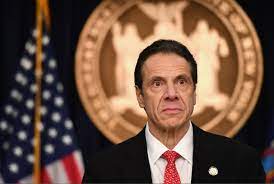
How Cuomo threw it all away
Watching the slow-motion implosion of Andrew Cuomo’s political career reminds me of the day back in 2015 when he gave me a tour of the second floor of the Capitol in Albany, musing about the place in history he hoped to occupy.
We were walking down the newly renovated Hall of Governors, lined with oil portraits of the 55 men who’d led the state before Cuomo — political giants with names like Roosevelt (Franklin and Teddy), Al Smith, Herbert Lehman, Nelson Rockefeller.
“It’s hard not to walk down this hall and get a palpable sense of the history and that you are a piece of that history,” he told me. “You are working here now, and at one point, there will be a date on the wall that is this date. And what did we accomplish? What did you do? And what have we done that would merit being on that wall?”

Even then, Cuomo had racked up achievements that guaranteed him a respectable place on the wall. He’d passed on-time budgets for the first time in years, and maneuvered and cajoled enough Republican lawmakers to pass the landmark law making same-sex marriage legal in New York.
He’d tightened restrictions on firearms with the SAFE Act, and launched the multi-billion-dollar replacement of the decrepit Tappan Zee Bridge with the same rough energy and urgency that’d he brought to the capital itself.
When workmen told Cuomo that the Capitol building — already 10 years into a renovation and filled with noise and scaffolding — would take another seven to complete, Cuomo applied his trademark blend of additional money and personal impatience. The job got done in less than two years.
That same forceful style carried over to major public works like the new Moynihan Station, the opening of the Second Ave. subway, the rebuilding of LaGuardia Airport and more. He even took his show on the road, sending a not-so-small army of public- and private-sector utility workers to Puerto Rico to help with rebuilding the island’s power grid after Hurricane Maria.
“Change is hard. And unless you’re working it every day, you’re not going to win,” he told me. “I understand that it’s a marathon, and I think that change takes time, so you should plan for a longer span. But I think you almost have to run it as if it is a sprint, because it is so hard to make change in this environment.”
The hopeful energy and undeniable accomplishment of those early years is now overshadowed by Cuomo’s disastrous, unforgivable mistreatment of the people around him, especially women. The ugly, abusive behavior cited in the attorney general’s report makes public what had been whispered about in Albany for years: that the second floor of the Capitol was often a snakepit in the Cuomo era, full of secrecy, petty power plays, personal deceit and public humiliation — all aimed at keeping the governor happy or punishing his enemies.
There are literally hundreds of case studies about the disasters that follow when people in an organization get punished for speaking their minds, or when a workplace turns into a competition for the personal approval of a capricious boss.
Cuomo’s top aides often take a perverse pride in their reputation for rudeness and scheming, calling it the price of Getting Things Done. The attorney general’s report makes clear the cost of such delusional thinking.
“I’ve been sexually harassed throughout my career,” the first of Cuomo’s harassment victims to go public, Lindsey Boylan, told investigators, “but not in a way where the whole environment was set up to feed the predator and this and every interaction I had with the governor and the culture felt like it was all to feed the predator.”
Charlotte Bennett, who was harassed by the governor, wrote a note to Boylan that all of Cuomo’s aides should take to heart.
“The verbal abuse, intimidation and living in constant fear were all horribly toxic — dehumanizing and traumatizing. And then he came onto me. I was scared to imagine what would happen if I rejected him, so I disappeared instead,” she wrote. ”My time in public service ended because he was bored and lonely. It still breaks my heart.”
Back in 2015, when Cuomo was showing me the Red Room — later made famous as the site of his pandemic briefings — he paused for a moment at the door. “Every time I touch this doorknob, I just think of all the hands over the years, » he said. “FDR, Teddy Roosevelt, Al Smith. Think of all the greats who opened this door.”
Cuomo will soon close the door for the final time, leaving it to the rest of us to reflect on how his administration went from triumphant to toxic — and how we can avoid a repeat of the errors that threaten to cut his career short.
Errol Louis is political anchor of NY1 News.
